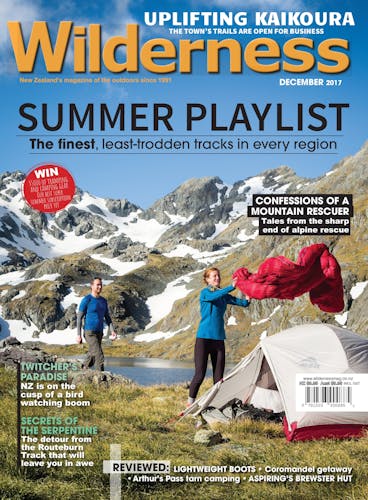Letter of the month
Inspired by bird watchers
I congratulate Helen Arthurs and her family on the commitment and resulting satisfaction they achieved from their year of bird watching (‘A big year’, October 2017).
It was refreshing to read about an ordinary family that embraced a unique challenge and followed it through, gaining knowledge of birds, their habitats, and general awareness of how to work together as a team to reach a goal.
I particularly enjoyed reading how they increased their target number of birds seen by 50 per cent, to further stretch themselves.
I hope other readers are inspired to set outdoor goals for their families from reading this article.
– Marianne Libeau
– Marianne receives a Peak to Plateau Kailash 1⁄4 Zip LS worth $160 from www.peaktoplateau.com. Readers, send your letter to editor@lifestylepublishing.co.nz for a chance to win.
Plant identification
The article ‘The battle above the treeline’ (October, 2017), mentioned that trampers could help detect weeds around huts by using apps. That can be done right now, as there is already an app and an online database. The app, iNaturalist, is available for Android and iPhone, and works offline.
After installation, simply photograph a species and the app will upload your observation when internet access is available. Volunteers from the group NatureWatch.org.nz will no doubt quickly recognise and identify the plant for you.
– Berend de Boer, email
Arches development eyesore
I take issue with Rosalie Sampson’s comment that the development of the Oparara Arches would be “the most wonderful thing that could happen” (‘West Coast High’, October 2017).
This is far from true. While the area could benefit from improved roading, parking and toilet facilities, the development proposals as they stand will have an incredibly negative impact on the arches and the surrounding landscapes.
The proposal includes building cell phone towers, a light show in the bush near the arches and a stainless steel gantry walkway through the arches themselves. Far from allowing tourists to experience the natural environment it would be seriously degrading it.
We are for changes which safely show people the fantastic natural landscapes of the area, not making it into a theme park.
– Murray Wilson, president New Zealand Speleological Society
Dangers of sharing tracks with bikes
For me, tramping and walking in the bush means to meditatively place one foot in front of the other, enjoying the rhythm of the moment. It allows me to listen to the birds and the wind through the trees, hearing the rivers and falls, talking with friends, having time to breathe the fresh air, taking time to relax the mind and enjoy my surroundings.
On a recent trip to Craigieburn Forest Park, I observed that mountain biking is for enjoyment too, but at a different pace, with the exhilaration of speed and the downhills. The mountain bikers code – ‘Respect others, respect the rules, respect the track’ – is but mere words. Where is the fun in carefully rounding a blind corner?
Having to grab my three-year-old off the track amid screaming brakes and yells of “there are more bikes on the way” is hardly meditative or even safe. Having to listen out for the whir of wheels distracts from the serenity of the moment and keeps me on edge. Time to switch off and think of the moment? I think not.
For me, segregation is the way forward for both safety and sanity.
– Nick Deane, Balcairn
More management needed
I am becoming more and more nostalgic for the New Zealand I grew up in. It was not overrun with tourists in the summer and when out in the hills there was a real sense of isolation and discovery. I fear the country we live in now and into the future is gradually having this experience eroded.
I support development, maintenance and progress, but it needs to be well managed and consulted on. I also support more Great Walks as long as they are away from the good tramping spots. Preferably near Auckland.
Also, with the argument around new restrictions on the Tongariro Alpine Crossing, I appreciate the view of the Federated Mountain Clubs, but feel a certain lack of facts. How many Kiwis actually walk the TAC? If the proportion is low then, by all means, I support DOC to regulate and manage as much as they like.
– David Short, email
Ways kauri gum was extracted
In response to your correspondent David Sidwell (Pigeon Post, November 2017), kauri gum was harvested in several ways.
The earliest method was by tree climbing, using boots fitted with toe and sole spikes, and handheld spikes. This damaged the tree, causing gum to weep out of the holes created.
Climbers later deduced that by boring into the trunk with a hand powered drill, the gum would exude, and could be collected by hanging tins under the holes. This practise was outlawed in 1905 because it caused damage to the tree.
The final method of harvesting was by digging for ancient gum on the site of earlier kauri forests. Over millennia, trees would die, fall over and be buried. Gumdiggers would probe the ground with gum spears to locate the gum which was then dug out of the ground. It was said that a competent digger could distinguish between a rock and a piece of gum by probing with the spear, a 2-3m long shaft with a small hollow in the sharp point which would collect small fragments of gum, thus confirming the identification.
In about 1910, kauri gum was our major export earner and was used to make varnish and linoleum.
– John Walsh, email
Weka in the North Island
Contrary to the article on weka (‘See more… weka’, October 2017), there is actually a very good wild population of North Island weka in the Matawai Motu Opotiki area. These birds are regularly seen and are a major part of the landscape.
This weka population has now also expanded towards the outskirts of Whakatane. Cyclists on the Motu Trails see the weka frequently, largely thanks to the Whinray Ecological Charitable Trust which has been working in the Motu area restoring kiwi and the North Island weka populations.
The article mentions Whirinaki as a place to see weka in the North Island. While it is true a translocation occurred there, the translocation was not successful.
Weka are really interesting birds. Forest & Bird’s ‘Bird of the Year’ competition described them as a ‘scatty, brown hen with a sophisticated criminal mind’.
This is the most apt description I think I’ve ever heard.
– John Lucas, DOC East Coast operations manager








